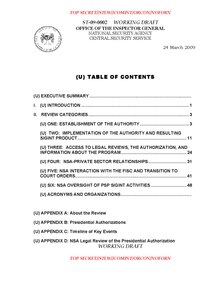Stellar wind

Stellarwind , Stellar wind (to German stellar wind ) or abbreviated STLW is also codename for the highest level of secrecy within the NSA , as well as code name for an under this highest level of secrecy part of the US President George W. Bush approved monitoring program President's Surveillance Program .
The Stellarwind component, made public through a leak from Edward Snowden , describes the extent to which the NSA is participating in the PSP program; the data retention of global Internet communication begun by the NSA and also its monitoring .
Background information
The National Security Agency (NSA) PSP program was approved shortly after the September 11, 2001 attacks and was first mentioned in The New York Times in 2005 by whistleblower Thomas Tamm .
The activities of the PSP program include the data mining of a large database ( repository ) for the classification of communications by American citizens ( e-mail traffic, telephone calls , chats ) as well as financial transactions and other Internet activities .
A report by the US Inspectors General (OIG) released in September 2015 indicated that President Bush originally ordered the collection of telephone and e-mail metadata only when a link to terrorism was suspected. In 2004, however , the US Department of Justice found that the NSA was collecting all metadata from purely domestic communications without any suspicion. Thereupon, however, Bush contradicted his own order: the NSA had always been fully legitimized to do so. However, according to Bush, NSA analysts would only review suspicious metadata. In fact, Bush changed the order later in 2004.
Around 2010, the US Department of Justice raised doubts about the legality of the program, as Stellarwind gave US intelligence agencies access to data at any time without a court order, even though the Foreign Intelligence Surveillance Act only allows this through court orders .
In June 2013 , the Washington Post and The Guardian published a secret draft OIG report dated March 2009, stolen by Edward Snowden from the NSA, describing the collection of global Internet communications.
See also
literature
-
Edward Snowden: Permanent Record . Pan Books, 2019, ISBN 978-1-5290-3566-7 (English).
- German edition: Permanent Record: My Story , S. Fischer Verlag, Frankfurt am Main 2019, ISBN 978-3-1039-7482-9 .
Web links
- NSA inspector general report on email and internet data collection under Stellar Wind - full document , The Guardian, June 27, 2013.
- Poitras, Laura . The Program . Nytimes.com, Op-Docs, Aug 22, 2012.
Individual evidence
- ↑ a b NSA Inspector General report on the President's Surveillance Program , March 24, 2009, page 10, note 3.
- ^ A b Edward Snowden: Permanent Record . Metropolitan Books, ISBN 978-1-250-75654-1 .
- ^ "Is the FBI Up to the Job 10 Years After 9/11?" April 28, 2011
- ↑ a b Michael Isikoff: The Fed Who Blew the Whistle: Is he a hero or a criminal? . In: Newsweek , December 13, 2008. Archived from the original on December 15, 2008.
- ^ A b Charlie Savage : George W. Bush Made Retroactive NSA 'Fix' After Hospital Room Showdown , New York Times . 20th September 2015.
- ↑ Charlie Savage: George W. Bush Made Retroactive NSA 'Fix' After Hospital Room Showdown . In: The New York Times . September 20, 2015, ISSN 0362-4331 ( nytimes.com [accessed November 1, 2019]).
- ↑ Daniel Klaidman: Now We Know What the Battle What About . In: Newsweek , December 13, 2008. Archived from the original on November 13, 2010.
- ^ Sanchez, Julian: What the Ashcroft 'Hospital Showdown' on NSA spying was all about . July 29, 2013. Retrieved July 29, 2013.
- ↑ NSA inspector general report on email and internet data collection under Stellar Wind . March 9, 2009. Retrieved August 1, 2013.
- ↑ Savage, Charlie, "redactions in US Memo Leave Doubts on Data Surveillance Program" , The New York Times , Sunday, September 7, 2014, p. A17